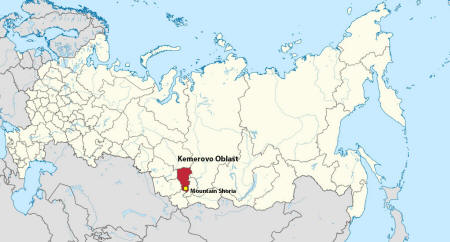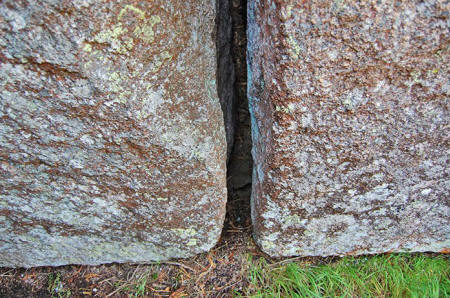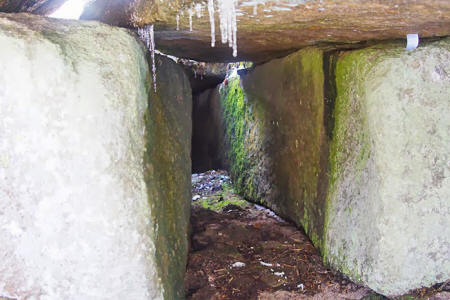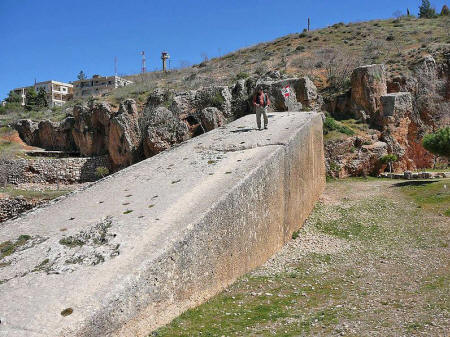|

by Michael Snyder
March 10, 2014
from
TheTruthWins Website
Spanish version

An
incredible discovery that was
recently made in Russia threatens to shatter conventional theories
about the history of the planet.
On Mount Shoria in southern
Siberia, researchers have found an absolutely massive wall of
granite stones.

Some of these gigantic granite stones are estimated
to weigh more than 3,000 tons, and as you will see
below, many of them were cut,
"with flat surfaces, right angles, and
sharp corners".
Nothing of this magnitude has ever been discovered
before. The largest stone found at the
megalithic ruins at Baalbek,
Lebanon is less than 1,500 tons.
So how in the world did someone
cut 3,000 ton granite stones with extreme precision, transport them
up the side of a mountain and stack them 40 meters high?
According
to the commonly accepted version of history, it would be
impossible for ancient humans with very limited technology
to accomplish such a thing.
Could it be possible that there is much
more to the history of this planet than we are being taught? For years, historians and archaeologists
have absolutely marveled at the incredibly huge stones found at
Baalbek.
But some of these stones in Russia are reportedly more
than twice the size.
Needless to say, a lot of people are getting
very excited about this discovery.
The following comes from a Mysterious
Universe article…
Alternate history buffs are about to
be whipped into a frenzy! OK, maybe not, but they will find
this interesting.
An ancient "super-megalithic" site
has been found in the Siberian Mountains.
Found recently in Gornaya Shoria (Mount Shoria) in southern Siberia, this site
consists of huge blocks of stone, which appear to be granite,
with flat surfaces, right angles, and sharp corners.
The blocks appear to be stacked, almost in the manner of
cyclopean masonry, and well… they're enormous!
Russia is no stranger to ancient
megalithic sites, like
Arkaim or Russia's Stonehenge, and the
Manpupuner formation, just to name two, but the site at
Shoria is unique in that, if it's man-made, the blocks used are
undoubtedly the largest ever worked by human hands.
When I say that this is a new discovery,
I am not kidding.
In fact, the very first expedition to study these
stones happened just a few months ago. Prior to this expedition,
there were no known photographs of these megalithic stones.
Archaeologist John Jensen is mystified by these ancient ruins, and
the following is an excerpt from a post
on his personal blog…
The super megaliths were found and
photographed for the first time by Georgy Sidorov on a recent
expedition to the Southern Siberian mountains.
The following
images are from
Valery Uvarov's Russian website.
There are no measurements given, but
from the scale depicted by the human figures, these megaliths
are much larger (as much as 2 to 3 times
larger) than the largest known megaliths in the world. (Example:
The Pregnant Woman Stone of Baalbek, Lebanon weighs in at
approximately 1,260 ton).
Some of these megaliths could easily
weigh upwards of 3,000 to 4,000 tons.
Below, I have posted some of the images
that he was referring to.
As you can see, they are absolutely
stunning…




Another very unusual thing about these
stones is that they caused the compasses of the researchers to start
behaving very strangely.
The following is an excerpt from a story
on a Russian news source…
Some events that were happening
during the autumn expedition could probably be called mystical.
The compasses of the geologists behaved very strangely, for some
unknown reason their arrows were deviating from the megaliths.
What could this mean?
All that was clear was that they came
across an inexplicable phenomenon of the negative geomagnetic
field. Could this be a remnant of ancient antigravity
technologies?
Of course much more research needs to be
done on this site.
Nobody knows who cut these stones or how
old they are.
Jensen believes that they come from a
time
"well back into the mists of pre-history"…
These megaliths reach well back into
the mists of pre-history, so far in fact, that conjecture about
their 'builders', methods, purpose and meaning is pure
speculation, and as such, I would hesitate to offer any
observation at all, other than to say our pre-historical past is
richer than we ever dreamed.
These stones are likely to remain an
unsolved mystery for a very long time.
But what is abundantly clear is that
according to the commonly accepted version of history
they
should not be there. And of course this is far from the only
site around the world that contains massive megalithic ruins.
Perhaps the most famous are
the megalithic ruins at Baalbek,
Lebanon…

The following is some information about
Baalbek from one of my
previous articles…
The ancient city of Baalbek is
one of the greatest archaeological mysteries of all time.
Located east of the Litani River in the Bekaa Valley of Lebanon,
Baalbek is world famous for its exquisitely detailed yet
monumentally scaled Roman temple ruins.
In Roman times, Baalbek
was known as Heliopolis (after the sun god) and it contained
some of the largest and most notable Roman temples ever built.
In fact, the Romans had constructed an extraordinary temple
complex in Baalbek consisting of three separate temples - one
for Jupiter, one for Bacchus and one for Venus.
But what these
Roman temples were built on top of is much more important.
These
Roman temples were actually built on top of
an ancient 5
million square foot platform that was made from some
of the largest stones ever used in any construction project in
the history of the earth. In fact, the largest stone found near
the Baalbek ruins weighs approximately 1200 tons and is
about 64 feet long.
To put that in perspective, that
is the equivalent of approximately 156 full size African
elephants.
How people in ancient times were
able to move such massive stones is a complete mystery. In
fact, these giant construction stones were stacked so closely
together that you can't even fit a piece of paper
between many of them.
Many of the architectural feats found at
Baalbek cannot even be duplicated with 21st century
technology.
Keep in mind that the base of the
Baalbek ruins alone weighs approximately 5 billion tons.
Evidence continues to mount that very
sophisticated technology was used in the ancient world.
These megalithic ruins are undeniable
reminders of highly advanced ancient civilizations.
|








